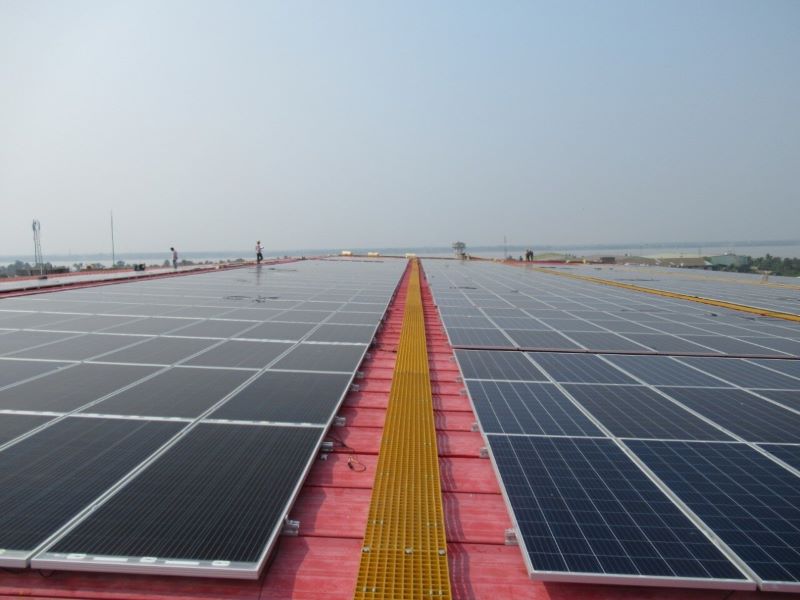 Solar Energy
Solar Energy Two-third of India's renewable energy capacity by 2030 would be from solar: Union minister
Kolkata/IBNS: The 450 GW of renewable energy target that the central government has aimed to achieve by the year 2030, almost 2/3rd of the same would come from solar energy, according to Union Minister Bhagwant Khuba.
Stressing on the huge opportunity this presents for the business houses over the period of next nine years, the minister of state for renewable energy said the central government has adopted a 360-degree view to address all the issues and clear all the roadblocks to achieve the target.
Khuba was speaking at the virtual event on Global Value Chains- Backward and Forward integration, in the session –Ecosystems for Solar Manufacturing in India, organised by industry body Associated Chambers of Commerce and Industry of India (ASSOCHAM) on Tuesday.
He pointed out India's shift from being an importer of solar power manufacturing equipment to becoming a generator of solar power.
“The government is also putting together a policy framework in this regard. However, I firmly believe that all this is not possible without the active participation of all the stakeholders,” he said.
Addressing the event joint secretary to the ministry of renewable energy Amitesh Sinha stated that India has a clear road map on part of demand visibility.
So, solar energy would contribute almost 300 GW to the renewable energy target that the country aims to achieve. India needs to add around 25 GW of Solar energy capacities every year. Apart from this, we are also moving towards a green hydrogen ecosystem,” he said.
Currently, the government is focusing on solving the problems in sourcing the equipment for solar power generation and how India can become 'Aatmanirbhar' (self-reliant) in this sector.
“The earlier efforts were not encouraging to the solar equipment manufacturers. Now with the government deciding to impose 40 per cent basic customs duty on solar modules and 25 per cent on solar cells from April 1, 2022, imports would become more expensive and local manufacturing would be encouraged,” he said.
Director and Partner, Auctus Advisors, ASSOCHAM’s energy consulting partners stated that currently the solar manufacturing space is dominated by China and while India has limited capacity in down stream value chain, it has no presence in the upstream.
“The government in the recent past has taken several commendable measures mostly focused on down stream value chain. Like the 40 percent basic custom duty on imported modules will restrict imports of cells. Also the Rs 4500 crores budget allocation on the PLI scheme will incentivize effective module production,” he said.
He further stated that to reduce the dependence, India needs to follow a roadmap with realistic targets to promote manufacturing of all components across the value chains.
Vineet Agarwal, Managing director of TCI and President, ASSOCHAM stated that domestic manufacturing ecosystem is critical for self-reliance and Atmanirbhar Bharat.
“Indigenous manufacturing of the equipment will reduce the recurring forex outgo of anywhere between $2.5 and $5 billion per annum to meet the projected demand of 450 GW by 2030. It will create 50,000 direct and 1.25 lakh indirect jobs, along with opportunities for MSME's in the associated supply chain. And will ensure energy security without depending on other countries and create resilient supply chains,” he said.
Agarwal noted that despite these policy push by the Indian Government, the global industry is highly concentrated, and competitiveness of domestic manufacturing will require comprehensive and sustainable policy support.
“The PLI scheme introduced by the government will help in creating the right ecosystem and help India go up the value chain,” he said.
Deepak Sood, Secretary General, ASSOCHAM stated that while the Indian solar power generation industry has immense potential, a robust domestic supply chain of solar equipment manufacturing will promote self-reliance and energy security as also preserve valuable forex reserves.
“Government of India has announced and implemented several initiatives to boost the solar manufacturing industry. ASSOCHAM and its members, we laud government’s efforts,” he said.
He further informed that despite policy directions, India’s domestic manufacturing capacity has been unable to keep pace with the growing solar generation capacity.
“An end-to-end a domestic supply chain is critical in making India’s solar equipment cost-competitive in the global market. Additional measures are needed especially in the upstream segments to ensure a sustainable integrated supply chain,” he said.
“For the industry to come up with the manufacturing capacity, the government also needs to ensure the demand for domestic products and enable cost competitiveness,” he added.
Support Our Journalism
We cannot do without you.. your contribution supports unbiased journalism
IBNS is not driven by any ism- not wokeism, not racism, not skewed secularism, not hyper right-wing or left liberal ideals, nor by any hardline religious beliefs or hyper nationalism. We want to serve you good old objective news, as they are. We do not judge or preach. We let people decide for themselves. We only try to present factual and well-sourced news.







